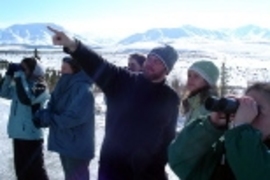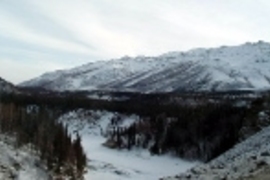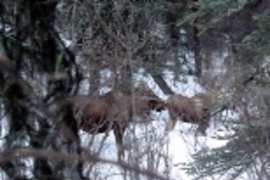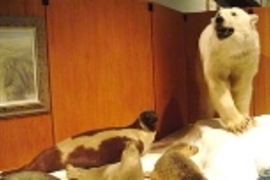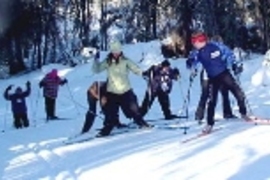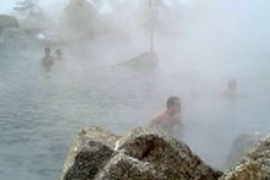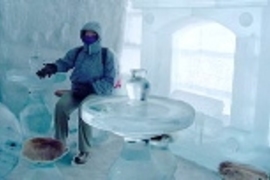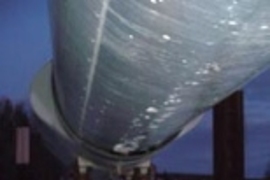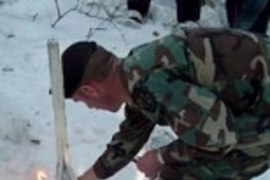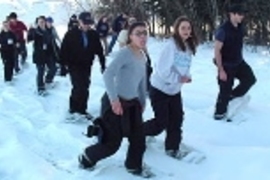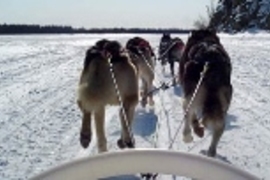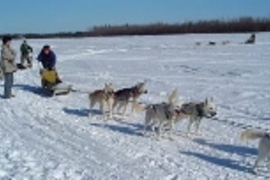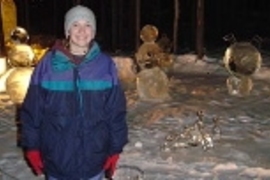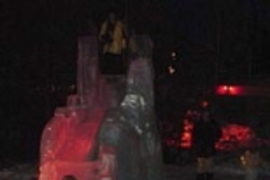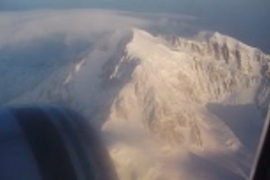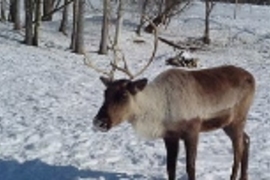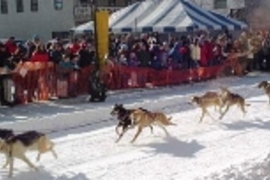While many college students are preparing to spend spring break in their bathing suits, 28 MIT freshmen are packing their heavy coats. They will spend March 19-29 in Alaska, hosted by the University of Alaska Fairbanks(UAF), to learn firsthand about the benefits and pitfalls of drilling for oil in the Arctic National Wildlife Refuge. Below are edited excerpts and photos from an online journal by freshman Matthew R. Zedler chronicling the trip. Check back for updates throughout the week.
Sunday, March 28, 2004
Leaving Alaska
Leaving Alaska is the most painful part, and the issue of drilling in ANWR is one that will be on many our minds for years to come. I am sitting in the plane, flying across the darkened and icy landscape below, trying to focus my mind and stay awake.
Backcountry management
As we were finishing eating [breakfast], a ranger from Denali started his slide show presentation about backcountry management. He talked about many of the issues managers face when trying to decide how much of a wilderness a certain area should be. With the increased tourism, planes and buses have become more predominant in Denali, and this definitely detracts from the wildlife value of the place. After he finished speaking, another ranger named Chad started his presentation about the SoundScape project being conducted in Denali. This research assignment used microphones and laptops to record sounds at different places in the park. The data was analyzed to see if any trends about park usage could be found, such as when planes frequented the area or what wild animals were present. It was interesting to see the contrast in man-made sounds versus natural sounds as the touristy nature of a location increased.
Natural treasures
Around noon, we grabbed our bags, snagged snack lunches that the chef had prepared for us, and headed out to Denali again for one last hike. The one ninety mile road which leads into the park had been partially plowed the week before, so they let the bus driver escorted by park rangers take us in about twenty or thirty miles to Savage River. On the way, we stopped at numerous outlooks, seeing dall sheep, golden eagles, ptarmigans, and even a moose. The countryside was absolutely amazing, not even comparable to the trail-crossed national parks we have back east, and I began to see how much the wilderness factor did really matter. I want natural treasures like Denali to be preserved for generations so my children can see such sights.
Many thanks
Before I forget, I want to thank everyone who has made this trip the experience it was. One last thanks needs to be given, and that is to you for taking the time to read this. Maybe you have learned something; I know this trip has definitely taught me a lot.
Friday, March 26, 2004
Exploring Nenana
We boarded the bus, headed out to UAF to grab snowshoes, and then started the hour-long trek out to Nenana. This small city was built up by the coming of the the railroad, and its economy today is primarily based on a state-wide lottery, the Nenana Ice Classic. In this unusual betting game, people pay $2.50 to buy a ticket and predict a time and date when the ice will break and a large pole on the ice will move far enough to pull a cable. Half the profits from the sale of tickets goes to the winner (about $300,000), and the other half goes directly to the city. A few Terrascopers and Kip bought tickets for this year's ice classic, so maybe we will have some big winners from Boston.
Moose soup and more
After that, we took the bus down to the Nenana School which houses grades K through 12. We walked from there over to the Senior Center for lunch. They served us an amazing meal consisting of moose soup, moose meat, smoked salmon, cooked salmon, dinner rolls with blueberry jam, cranberry scones, and peanut butter cookies. The meat was rather interesting, and moose tastes very similar to a chewy beef. The fish was a little less appetizing, though I think that may have just been me. I loved the fresh fruit jam, especially on the warm dinner rolls.
Denali
We hopped back on the bus for the second leg of our long traveling day. The changing scenery was absolutely amazing, and you could see the mountains rising out of the flatlands. The frozen tundra was white and cracked, punctuated by evergreen trees. We saw Denali as we approached it, but I fell asleep about twenty minutes before we got there.
Delayed by a moose and calf
Upon reaching the park, we went into the rangers' building. The head ranger welcomed us, then one guy came out and showed us his presentation. It was a slide show of the four seasons of Denali set to music, and it was very beautiful. We next headed back to the bus to get in cold weather gear. Once suited up, we split into four groups and followed rangers into the wilderness for a short hike. On the way back, we rounded a bend and came across a moose and its calf. These creatures are massive, so we sat back and watched it chew up some bushes for a while. This delay was a long one, but well worth it.
Thursday, March 25, 2004
Kaktovik point of view
Today was another exciting day, and one of the better as far as discussions go. First, I received a rather interesting e-mail from someone who supported the Inupiat of Kaktovik. He or she basically asserted that we were being "hoodwinked" by our tour guides by only hearing the Gwitch'in perspective; unfortunately, he or she did not look at our itinerary since we spoke with someone representing the people of Kaktovik today.
Our first speaker at UAF was Karl Francis, a white man from Canada who was representing the people of Kaktovik. It seemed to many of us that the people of Kaktovik were a little unrealistic in their expectations. Having lived on the land since the beginning of time, they believed that development of the Arctic National Wildlife Refuge 1002 Area under their oversight would be a good thing as it would bring revenues into their villages and allow the people to basically modernize. Of course, such control of big oil seems rather slippery to me, so I don't know if that could be secured. The one big point that hit home was that this issue is more than an environmental one; it also has a face of human rights. I believe that we missed driving this point home during the first semester, but I think that it is one that must definitely be incorporated in the final solution to this complex problem.
"The most useful lecture"
We moved on over to the UAF Woods Center, where we met with a distinguished panel to discuss all aspects of this issue. In my opinion, this was that most useful lecture of the series since we actually had enough time to ask meaningful questions. The panel included former Alaska Attorney General Grace Schaible, author Debbie Miller, former Fairbanks mayor Jim Sampson, wildlife biologist Fran Mauer, oil refinery owner Jeff Cooke, politican John Davies, and Karl Francis.
As you can well imagine, both extremes of the issue as well as the middle were well represented in this group. Many questions were asked, but some of the most provocative for me concerned the future of Alaska. Its economy is now based 86 per cent on oil and gas, but most people predict that this resource will run out sooner rather than later. Unfortunately, Alaska currently has no big plans for when that day comes, and their second major industry (tourism) falls orders of magnitude behind oil and gas development. One of the big things on the horizon is the development of a natural gas pipeline, which even Deb Miller supported since natural gas burns much cleaner than gasoline. Another prospect that was raised was the exploration of geothermal energy to break apart natural gas into hydrogen -- if that technology ever emerges.
From cross-country to curling
We all gathered and walked over to the UAF ski shack to get cross-country skis and try out this new sport. We went off in a group following our guide, a student on the UAF ski team. The downhill was a lot more difficult than with the usual downhill skis, and I fell into a nice big snowbank when I got stuck in a rut going down one slope. The uphill is all right, but it is rather tiring. All in all, it was a great experience, and I would love to do it again sometime.
Returning our skis, we got back on the bus for a trip over to the local curling club. Curling is a sport where you get to slide a 42-pound rock down an icy floor and try to have it stop in a large landing zone which looks like a bull's-eye. To complicate matters, you have two sweepers who go in front of the slow-moving stone to smooth the ice by rubbing it vigorously with a small broom. In a nutshell, it is a combination between shuffleboard, darts and horseshoes. I had lots of difficulty staying upright while sliding the stone. I even had problems sweeping, falling over the opposing team's puck and causing it to careen out of our game.
Wednesday, March 24, 2004
Native cultures
We started our first lecture with Nancy Furlow, a professor of native culture at the University of Alaska Fairbanks. She talked about the Tlinget people of the southeast corner of Alaska. Nancy is a native of the Raven moity, which is a division of the Tlingets.
In addition to speaking about her own people, Nancy talked about other native people including the Athabascan and Aleutians. Hearing how the Aleutians had adapted to the windy, treeless islands was inspiring. They specially trained their young men to endure sitting in a kayak for weeks on end when the whale hunt came around.
Tundra contaminents
The last speaker we heard was Dr. David Barnes, also a professor at the university, who talked with us about contaminents on frozen tundra. His presentation was rather technical but still interesting, especially when he talked about the case study oil spills they did back in the 1970s. It was also interesting to hear how his conclusion that oil did indeed seep into and through permafrost contrasted with Kevin Meyer's statement that "oil can just be sucked off the ice" in the winter.
Icy inn
Later at Chena Hot Springs, a tour guide took us out to the ice hotel that was built last year. It is the only one of its kind in the United States, and guests pay about $600 a night for a room. The beds are made of ice but have a reindeer hide and several blankets to sleep on and under, so it is supposedly rather warm. The engineering and architecture behind it was pretty amazing, but I definitely wouldn't have spent the night there unless someone paid me.
Hot revival
After that, we changed and ran into the hot springs. The water was very warm, and steam rolled off the surface as the cold wind blew. Ice strips were soon seen in hair since it was well below freezing above the water's surface. Some crazy kids decided to see how long they could stay out of the water, but that contest was ended when Ari and Kip decided that frostbite might ensue.
Tuesday, March 23, 2004
As we start to work our way through the week, Alaska's magnificence and appeal continues to grow. I continue to see amazing sites and beautiful places that make me brave the cold (and the layers of garb such excursions require) to go back out into the snow.
Two sides of the oil drilling debate
At the University of Alaska Fairbanks, we went down to the media classroom where we started a teleconference with Rosemary Ahtuangarukak, the mayor of Nuiqsut. Nuiqsut is an Inupiat village located on the North Slope near Prudhoe Bay and Alpine, both of which are oil drilling sites. Though we managed to lose the connection twice, the mayor still gave a good lecture about how development has changed the way of life in her village forever. The caribou and whale populations have been disturbed, the people are getting asthma at much higher rates, and prices of goods were still appallingly high. One other interesting thing to hear was that the development, which was supposed to bring jobs to the natives, did not bring employment at as fast a rate as expected because of all the certifications and training required to work for the oil companies.
Around 9:00, Kevin Meyers, the CEO of Conoco Phillips, the largest oil producer on the North Slope, came in to provide us with his side of the argument. Mr. Meyers, an excellent public speaker who is an MIT alum, made the "mistake" of opening the floor to questions, so we bombarded him with lots of different and pointed questions. He fielded them rather well, and one of his big points was that the global economy really fueled the oil industry. The public compelled them to open up in these areas because of its insatiable desire for oil and all the products it provides. Mr. Meyers definitely made a good case from an economic and societal perspective for the continued development of the North Slope for oil resources.
Cold transport
Later, at a Chamber of Commerce meeting, I talked with Roger Burggraf, an older man who had once used sled dogs to transport freight. He told me a story about how people used to walk between Valdez and Fairbanks (~400 miles) because they could not afford the stage. Some would freeze to death along the way, and the stage would pick up their frozen bodies during its run, tie them to the roof, and bring them to Fairbanks to defrost and be buried. I got Roger's card so we could contact him more if we had questions about transportation and its evolution in Alaska.
The pipeline
On the way back to the hotel, the bus stopped briefly at the Trans-Alaskan Pipeline so we could see what we had been talking about first semester. It was cool to actually see the pipeline, and it made our research seem so much more concrete. Unfortunately, my team also decided to throw me in the snow under the pipeline ...
Monday, March 22, 2004
Snowshoeing with the Army
At the University of Alaska Fairbanks, we went into the ROTC building. There, a sergeant from the Army and four sophomores showed us how to fit snowshoes. We put them on, went outside, and began trouncing around in the loosely packed snow in a field. This snow, only a few feet deep, was nothing compared to the six-foot drifts we will be walking through in Denali. We were led through woods and up hills, and got to slide down a sledding hill by sitting low on the shoes. They were not that hard to manage, though I did fall down several times. At the end of the time, the staff sergeant showed us why the Army had chosen to make its snowshoes out of magnesium. He scraped off some chips and used them to light a fire since magnesium is very flammable. It was very cool, and I would love to do it again.
Sunday, March 21, 2004
A native viewpoint
Today we met with Faith Gemmill, a Gwitch'in native who was a member of the Gwitch'in Steering Committee. I had contacted her about possible interviews with Gwitch'in elders, so it was great to get the chance to meet her. She showed us a video about her people and their fight against oil development, and then spoke very passionately on the issue. She has a certain fire in her voice and eye that could be seen even though she was very tired from a week-long series of meetings. Faith told us stories of how she had grown up with the caribou and how she wanted to pass knowledge of the herd on to her children. I was fascinated and found it really hit home when she talked about how the lack of outside distractions in the natives' villages allowed more knowledge to get passed down. Could it be that in our fast-paced society, too many distractions keep us from remembering?
The afternoon mush
This afternoon, we got to go mushing, an absolutely amazing activity. I sat on a sled while several huskies pulled me around a mile-long loop on a frozen river. I shot excellent footage for our exhibit, as did Jerald, the cameraman who is following our class around. I got to talk with several of the mushers about the sport, and I learned several things. The dogs can run anywhere from 30 to 120 miles a day, pointers are more often used than huskies now, since they are faster and not as hairy. "Gee" means left and "haw" means right, and most dogs on the team are between two and eight years. One of the mushers let us play with her team, so I got to pet down Skittles, an excited pup who kept whining when I stopped petting her. While there, we also got some footage of snowmobiles, four-wheel off-roaders, and planes.
Frigid art
The bus then took us to the Ice Art Park, a place that has to be seen and is rather hard to describe. The artists had sculpted an amusement park out of ice, making slides, spinny tops, mazes, and even a cave. There were also several hundred sculptures made by artists from various parts of the world. The pictures hardly do justice to the engineering and artistic achievement of these people.
Saturday, March 20, 2004
Flying in
I neglected to mention my interesting seatmate on the plane. Jeff worked on the Trans-Alaska pipeline and had driven rock trucks and water trucks to make ice roads for oil rigs. He talked about the Athabascan natives, especially how the old men hang out in the bars in Anchorage. He also told me the most snow he had seen fall at one time was five feet. That five feet was blown by gusts of wind against his mobile home, forcing him to dig out and up when he opened his door.
We left Anchorage at 6:00 this morning. I tried to read Walden but couldn't concentrate; instead I stared out the window at a landscape that was as foreign to me as that of the moon. Everything was white and jagged, massive mountains pointed skyward into a crystal sky and frozen rivers streamed around frozen shores. Forests showed up on the landscape below, lit by the rising sun, but little human habitation could be seen. As we neared Fairbanks, our pilot took a slight detour and pointed the plane towards Mount McKinley (20,300 ft.). I have to say that as the plane swooped around the summit and we seemed to be hovering a stone's throw above the rock, I realized what an incredible place Alaska was. I cannot even imagine climbing to such a height - Mount Baldy at 14,000 ft. in New Mexico was trying enough.
The cold here is a dry cold, but you can still feel it. The most interesting thing is that the snow is so cold it no longer sticks together and instead crackles as you walk on it.
Large animals
At the Fairbanks Large Animal Research Center, Rebecca the guide showed us musk oxen, reindeer, and caribou that were being studied for research purposes. The musk oxen, which are neither oxen nor smell musky, were the first animals we saw. These shaggy beasts are the largest member of the goat family, and they have massive horns which they bump together when rutting or just playing. They can run up to 30 mpg but don't often do that since they have a tendency to overheat. The reindeer and caribou were housed in the next pens, and they looked very similar in many regards (in fact, they sometimes interbreed). One big difference is that reindeer can be haltered while caribou cannot. It was a neat experience actually getting to see the animals we've discussed for so long.
Small animals
Back at the hotel, we went out to see the dogsled race that was starting next door. We managed to get many pictures and some video which will hopefully be useful for our exhibit on evolution of transportation, and also learned something about the sport just by watching. The dogs that are run now are no longer huskies; instead, smaller, faster dogs are used. They would play, whine, and run around until they were put on the sled; then they would tense and get ready for their almost 30-mile run.
The big picture
At 5:00, the group went over to the local museum and heard a talk by Bill Hollman about the different ecosystems in Alaska. It was rather interesting to hear how that central arid region contrasted with the wetter outer regions, and it was also amazing to be reminded again that Anchorage, which had seemed so small, was the largest city in Alaska. Also, did you know there were swarms of mosquitos in the summer months up in Arctic National Wildlife Refuge?
